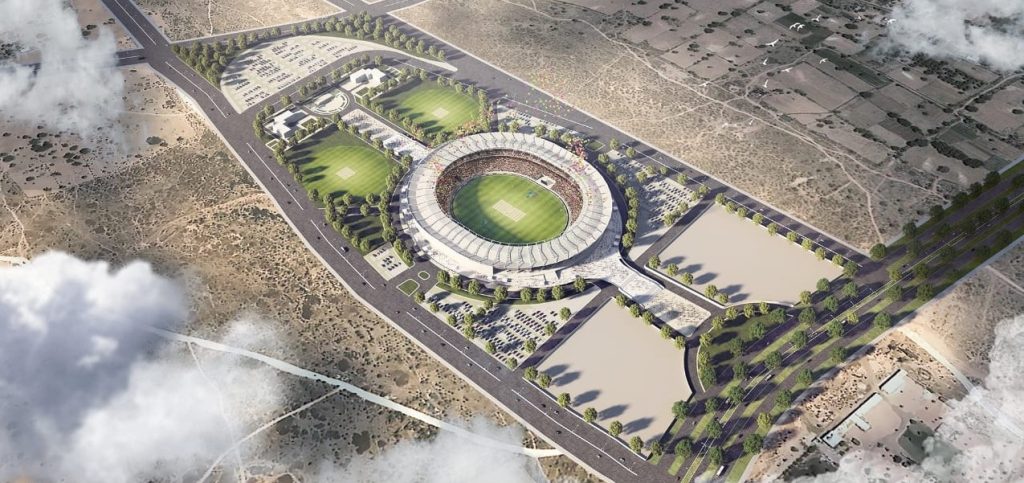The Sawai Mansingh Stadium, commonly referred to as the Jaipur Cricket Stadium, is a significant venue in India’s cricketing landscape. Located in the heart of Rajasthan’s capital, this stadium has hosted numerous memorable matches, including One Day Internationals (ODIs), T20 Internationals, Indian Premier League (IPL) games, and domestic tournaments. While fans admire the passionate crowds and iconic pink seats, players and analysts focus on something more technical: the boundary dimensions.
Table of Contents
In cricket, the length of the boundary can drastically influence the outcome of a match. Whether it’s a batter deciding to go aerial or a captain setting up field placements, the boundary distance plays a pivotal role. This article explores the boundary length of Jaipur Cricket Stadium, its significance in gameplay, and how it compares with other venues in India and around the world.
Understanding Boundary Length
In cricket, boundary length refers to the distance between the central pitch and the rope or fence that marks the edge of the playing field. Depending on the stadium layout, the boundary can vary in different directions — such as straight down the ground, square of the wicket, and behind square.
Boundary lengths impact:
- Batting tactics (hitting sixes vs. running twos)
- Bowling strategy (line and length control)
- Field placements
- Scoring rates
Jaipur Cricket Stadium: An Overview
| Parameter | Value |
|---|---|
| Stadium Name | Sawai Mansingh Stadium |
| Location | Jaipur, Rajasthan, India |
| Year Established | 1969 |
| Seating Capacity | ~30,000 |
| Primary Teams | Rajasthan Royals (IPL), Rajasthan (domestic) |
Boundary Dimensions at Jaipur Cricket Stadium
| Boundary Direction | Approximate Distance (meters) |
|---|---|
| Straight (long on/off) | 70 – 72 |
| Square of the wicket | 63 – 67 |
| Behind square | 60 – 64 |
| Cover/Extra cover region | 65 – 68 |
Average boundary length (perimeter estimate): 250–270 meters
ICC minimum standard for international grounds: 65 meters (minimum), 85 meters (maximum)
Compared to some larger stadiums like the MCG or Eden Gardens, Jaipur offers moderately sized boundaries, making it a fairly balanced venue for both batters and bowlers.
Effects of Boundary Size on Gameplay
1. Batting-Friendly but Not Overly Small
The shorter square boundaries allow aggressive batters to target leg-side and off-side areas, especially in the IPL, where high-scoring games are common. However, the longer straight boundaries ensure bowlers are not completely out of the contest.
2. Bowler Strategy
Spin bowlers often enjoy success at Jaipur due to the surface conditions. The medium-sized boundaries allow them to flight the ball and invite big shots — increasing the chances of mistimed hits being caught in the deep.
3. Running Between the Wickets
Comparative Analysis: Jaipur vs. Other Indian Stadiums
Cricket Stadium Boundary Sizes in India
| Stadium | Straight (m) | Square (m) | Average Perimeter (m) |
|---|---|---|---|
| Sawai Mansingh (Jaipur) | 70 – 72 | 63 – 67 | ~260 |
| Wankhede (Mumbai) | 65 – 68 | 60 – 65 | ~240 |
| Eden Gardens (Kolkata) | 66 – 70 | 63 – 68 | ~255 |
| Narendra Modi (Ahmedabad) | 75 – 80 | 65 – 70 | ~270 |
| M. Chinnaswamy (Bengaluru) | 63 – 66 | 58 – 62 | ~235 |
As seen in the table, Jaipur has slightly larger boundaries than Bengaluru or Wankhede, but not as long as Ahmedabad’s Narendra Modi Stadium. This makes Jaipur a neutral ground in terms of scoring potential.
IPL and Boundary Strategy in Jaipur
The Rajasthan Royals have used the dimensions of the stadium tactically during IPL matches.
- In 2022 and 2023, spinners like Ravichandran Ashwin and Yuzvendra Chahal thrived due to the ability to set deep fielders and force errors from batters.
- Batters such as Jos Buttler often target the square leg and midwicket areas, where the boundaries are most accessible.
Average Scores at Jaipur in IPL (Last 5 Seasons)
| Match Type | Average First Innings Score |
|---|---|
| IPL Matches | 165 – 175 runs |
| T20 Internationals | 160 – 170 runs |
| ODIs | 270 – 285 runs |
These averages indicate that Jaipur is moderate in run production, neither excessively high nor too low.
Boundary Size and Field Placement
Due to its balanced dimensions:
- Captains often place deep square leg and long-on/long-off fielders as key catching positions.
- Fast bowlers bowl back-of-length deliveries, using the long straight boundary to force batters to mistime.
- Spinners vary pace and invite aerial misjudgments, confident that the medium-sized boundaries offer a margin for error.
Future Development Plans
With the rise of T20 leagues and increasing demand for entertainment:
- Jaipur stadium may consider adding flexible boundary ropes for different formats.
- Technology such as drone-assisted measuring and real-time boundary tracking could be introduced to aid commentators and analysts.
The boundary length of Jaipur Cricket Stadium is a core characteristic that influences everything from team selection to match tactics. With straight boundaries of around 70–72 meters and square boundaries of 63–67 meters, it is a ground that balances fairness and excitement. It’s large enough to reward good bowling and fit field placements, yet short enough to ensure fans see plenty of boundaries and sixes.
Whether during a high-octane IPL clash or a tense ODI, the dimensions of the field shape the spectacle on display. As cricket evolves, the role of boundary lengths — especially at storied venues like Jaipur — will continue to be a fascinating topic of strategic discussion.


